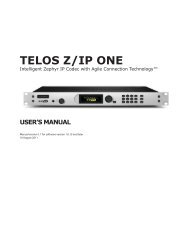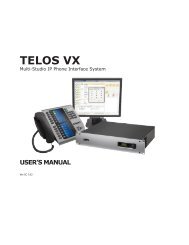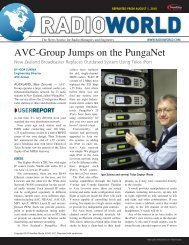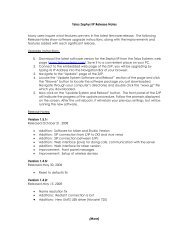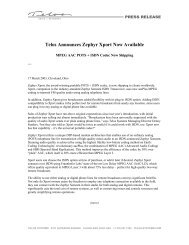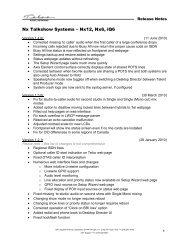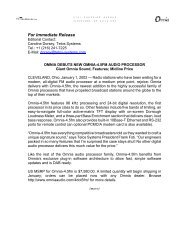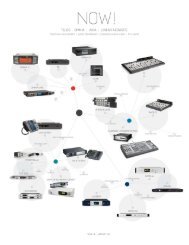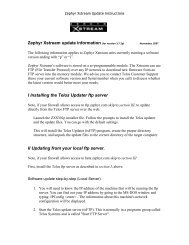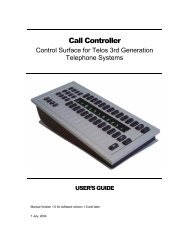Hx1-Hx2 Manual-1.4.1 - Telos
Hx1-Hx2 Manual-1.4.1 - Telos
Hx1-Hx2 Manual-1.4.1 - Telos
You also want an ePaper? Increase the reach of your titles
YUMPU automatically turns print PDFs into web optimized ePapers that Google loves.
A8 | appendix 1<br />
Glare – On a POTS line an incoming call is signaled by periodically applying an AC ring<br />
voltage to the line. Since there is a semi random period before the ring, and pauses between<br />
rings, it is possible to seize a line which is “about to ring” (and answer a call) when attempting to<br />
place an outgoing call. When this scenario happens it is called glare. Glare is much less likely if<br />
Ground Start or ISDN trunks are used. See also Ground Start Trunk.<br />
GR-303 - See SLC-96.<br />
Grade of service- This is simply the ratio of calls blocked to total calls in a decimal form.<br />
Therefore, a grade of service of P.08 would represent 8% blocking. Telephone tariffs regulate<br />
the acceptable average grade of service which must be provided on public networks. See also<br />
Blocking.<br />
Ground Start Trunk – A type of telephone trunk where the request to make an outgoing call<br />
(i.e. request for dial tone) is made by briefly grounding the Tip conductor. Many PBX system<br />
use ground start trunks as they are less prone to glare than Loop start trunks. Ground start lines<br />
are sometimes used with equipment designed for Loop Start lines. This may or may not work -<br />
generally it serves to prevent outgoing calls while incoming calls work normally. Telcos may call<br />
these “ground start lines”. See Loop Start Trunk. See also Glare.<br />
GTD-5 - The GTD-5 EAX (General Telephone Digital Number 5 Electronic Automatic<br />
Exchange) is the Class 5 telephone switch developed by GTE Automatic Electric Laboratories.<br />
This digital central office telephone circuit switching system is used in the former GTE service<br />
areas and by many smaller telecommunications service providers. It does not support ISDN.<br />
HDSL - High-Data-Rate Digital Subscriber Line. HDSL delivers 1.544 Mbps of bandwidth<br />
each way over two copper twisted pairs. Because HDSL provides T1 speed, telephone companies<br />
have been using HDSL to provision local access to T1 services whenever possible. The<br />
operating range of HDSL is limited to 12,000 feet, so repeaters can be installed to extend the<br />
service. HDSL requires two twisted pairs, so it is deployed primarily for PBX network connections,<br />
digital loop carrier systems, interexchange POPs, Internet servers, and private data<br />
networks. DC voltage used to power the network Interface Unit (NIU) is “phantomed” between<br />
the two pairs. See NIU.<br />
Hunt group- A group of telephone channels configured so that if the first is busy (engaged) the<br />
call goes to the next channel, if that channel is busy it goes to the next channel, etc. Hunt groups<br />
may hunt from the highest to the lowest, the lowest to the highest, or on some other arbitrary<br />
pattern. But the order of hunting will usually be fixed, beginning with one channel and working<br />
through (“hunting”) until an unused channel is found. The term may have originated back in<br />
the old manual switchboard days when the operator literally hunted for an unused jack to plug<br />
a cord into. This arrangement is very common in business scenarios where a single incoming<br />
number (the Listed Directory Number) is given to the public, but multiple incoming channels<br />
are supported. See also LDN.<br />
Hybrid – A device which converts from a two-wire signal such as POTS lines (or a 2-wire<br />
intercom) to a four-wire system (separate send and receive paths) such as used in the pro-audio<br />
world. While this task is theoretically quite simple, the fact the impedance of most phone lines<br />
varies widely across frequency complicates matters. The <strong>Telos</strong> 10 telephone system was the first<br />
practical DSP based hybrid and applied the then brand-new technology to this problem.<br />
IEC -1) Inter-exchange Carrier. “Long Distance” carrier. Handles Interlata and interstate calls.<br />
Most often referred to as IXC.<br />
IEC - 2) International Electrotechnical Committee. A European standards body best known for<br />
the power plug now used throughout the world for AC power cords for use on office equipment<br />
and computers.



